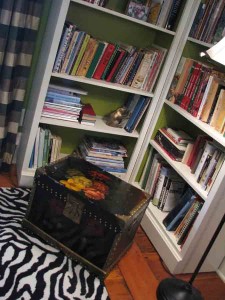
 The conventional wisdom of the home as a vanilla box with white ceilings is over. Many people, including an increasing number of home buyers, are seeking a higher level of design, and sometimes even a bit of energy and drama. However, color is such a strong element and can easily be overdone. The color scheme of your home, including all the materials and finishes, should create a cohesive and pleasing composition in total. Each design element, from one surface and space to the next, should flow and blend gracefully in color, texture, intensity and scale. The ceiling is often overlooked as a design element for color use. Especially if you have a high or stepped ceiling design, color can be very effective when used overhead.
The conventional wisdom of the home as a vanilla box with white ceilings is over. Many people, including an increasing number of home buyers, are seeking a higher level of design, and sometimes even a bit of energy and drama. However, color is such a strong element and can easily be overdone. The color scheme of your home, including all the materials and finishes, should create a cohesive and pleasing composition in total. Each design element, from one surface and space to the next, should flow and blend gracefully in color, texture, intensity and scale. The ceiling is often overlooked as a design element for color use. Especially if you have a high or stepped ceiling design, color can be very effective when used overhead.
 When designing a color scheme, I generally like to choose a fairly neutral palette for surfaces that are of a more permanent nature, such as flooring materials, ceramic tile, countertops, granite or stone, etc. This approach is a solid plan for longevity. The color punch and fun accents can be added with items of a lower price tag that allow for replacement as you grow tired of them or they become outdated. Paint is a great way for adding accents as it is relatively inexpensive and easy to change. Finishes and stains for wood surfaces- cabinetry, wood floors and furniture, offer a great opportunity for tying the scheme together. Repetitive items such as door and cabinet hardware and finishes of fixtures make an important contribution to your overall color scheme.
When designing a color scheme, I generally like to choose a fairly neutral palette for surfaces that are of a more permanent nature, such as flooring materials, ceramic tile, countertops, granite or stone, etc. This approach is a solid plan for longevity. The color punch and fun accents can be added with items of a lower price tag that allow for replacement as you grow tired of them or they become outdated. Paint is a great way for adding accents as it is relatively inexpensive and easy to change. Finishes and stains for wood surfaces- cabinetry, wood floors and furniture, offer a great opportunity for tying the scheme together. Repetitive items such as door and cabinet hardware and finishes of fixtures make an important contribution to your overall color scheme.
COLOR WITH A PURPOSE
I like to use accent colors in very strategic ways. Accentuating architectural features or the geometry of a space can create intentional and sometimes stunning surprises. Color can also be used to visually bring certain features forward or to highlight small details of a favorite object that otherwise might go unnoticed. Think of using color as a backdrop for living- to complement, support and enhance the activity that takes place in a specific area.
One of the biggest misconceptions is that dark colors make a space look smaller. This can happen, but it depends on many factors. The shape of the space, ceiling height, furniture, artwork and other objects in tandem determine the perception of any particular color. The amount and type of natural and artificial lighting play a big role. Ultimately, there are no hard and fast rules when it comes to using color effectively.
See conclusion… part 3
Related posts:
Tags: color, Landscape design
Leave a Reply Cancel reply

More Story
COLOR, COLOUR EVERYWHERE!... part 1
No matter how you spell it, color is one of the most useful tools in the design toolbox. Our spaces are dominated by drywall...Subscribe to the Blog
Site Menu
Recent Posts
- What's a gardener to do... in winter?
Jan 22, 2024 - New Year, New Plans!
Jan 1, 2024 - The Thoughtful Host
Dec 7, 2023
- What's a gardener to do... in winter?

You may link to a post or take quotes if credit, including a link back, is given.
You may not take entire posts or photographs without asking.
Permission may be requested using the contact form .















Share On